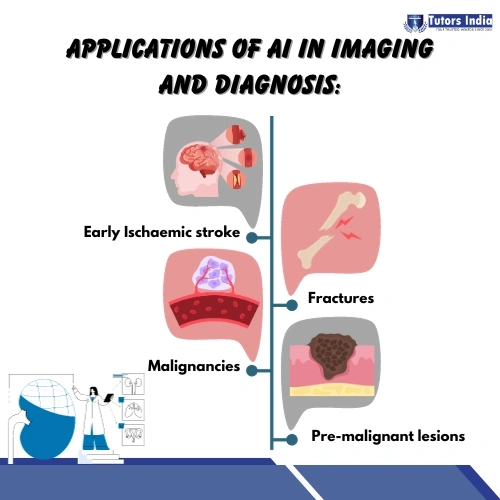Future Research Directions on the Applications of AI in imaging and diagnosis
Artificial Intelligence in the field of Medicine and Healthcare
Artificial Intelligence (AI) represents an emerging field in science and technology. Its influence spans across various aspects of human life, impacting individuals, social circles, businesses, and even countries. AI is growing rapidly, permeating nearly every industry and societal sphere, from IT, commerce, and manufacturing to space exploration, remote sensing, security, defence, transportation, and vehicles. Notably, in the 21st century, AI has made significant strides in integrating itself into the field of Medicine and Healthcare.
The use of artificial intelligence (AI) in medicine and healthcare constitutes a continuing revolution and has yet to be widely understood. This integration has the prospect of significant breakthroughs but also introduces uncertainties as well as serious problems. In addition, AI has already paved the path for completely revolutionary techniques in this discipline.
AI and its related technologies within Medicine and Healthcare have undergone remarkable development, transitioning from mere computer programs aiding in medical image analysis to their integration across nearly every clinical and administrative domain (Gómez-González, 2020).
Artificial intelligence in imaging and diagnosis
Research has shown that AI has displayed remarkable precision and sensitivity in spotting abnormalities in imaging, offering the potential to improve the detection and understanding of tissue-related issues.

AI could detect changes in image patterns that humans might not notice. For example, using machine learning to assess brain MRI data has the potential to detect tissue changes associated with early ischaemic stroke quickly after symptoms develop, and this technology may give more sensitivity than a human examiner within a restricted timeframe (Oren, 2020).
AI-based medical devices (AMIDs) have gained popularity in recent years, thanks to technological advancements in AI and Machine learning. AMIDs assist in the diagnosis, management and pharmaceutical development for various diseases. AIMDs have shown noteworthy results in the diagnosis and prognosis of common diseases (CDs) (e.g., breast malignancies, brain tumours and fractures)(Hasani, 2022).
Complex Neural Networks (CNNs), a subtype of Artificial Intelligence, can also be used for imaging and diagnosis. CNNS have been successfully implemented to diagnose breast cancer, lung cancer and brain cancer with high performance.
AI can help in the classification and detection of pre-malignant lesions and cancers. A classic example where automation can be used is indeterminate pulmonary nodules, which are usually benign are found frequently, of which a small proportion represent early stage cancers.
Another way AI is helping oncologists is by improving outcome prediction and detecting recurrences earlier after therapy. Exact prediction could help in adjusting therapy for patients before treatment begins. This means that instances deemed high-risk may receive more aggressive initial treatment, such as increased radiation doses, whilst those deemed low-risk may receive less intense treatment to minimise adverse effects (Hunter, 2022).
Future Research Directions
While conducting a literature review on the applications of AI in imaging and diagnosis, the following research areas were identified, which could serve as a dissertation topic for master’s students:
- A study on the synergistic effects of algorithms for diagnosis
Mirababie et al. (2021) studied how algorithms can be used in diagnosing diseases, and it was discovered that some algorithms have researched more than others, leading to a research gap. Future research directions can include how combining various algorithms compare with using a single algorithm for diagnosis.
- A study on clinicians’ perspectives on the limitations of Artificial Intelligence in diagnosis
A study by Kumar et al. (2022) delved into the applications and limitations of Artificial Intelligence in imaging and diagnosis. It was revealed that many healthcare professionals found artificial intelligence beneficial, although there were limitations regarding the data size and generalisability. Future research can deal with obtaining feedback from healthcare professionals and clinicians about the limitations in AI-driven diagnosis. Adjusting algorithms based on feedback can help improve the accuracy of diagnosis.
Conclusion
The application of Artificial Intelligence (AI) in Medicine and Healthcare is a developing sector with enormous potential. Despite uncertainties and limitations, artificial intelligence (AI) continues to transform medical imaging and diagnosis, exhibiting outstanding precision in detecting discrepancies and helping in disease management. AI-based medical device improvements have shown potential in identifying many ailments, whereas Complex Neural Networks exhibit high performance in diagnosing cancers. Future research directions include investigating algorithm synergy for diagnosis and addressing clinicians’ viewpoints to improve the accuracy of AI-driven diagnosis.
About Tutors India
Tutors India comprises a team of expert researchers and academic writers offering assistance to master’s students in dissertation and coursework. We strictly abide by the university guidelines while offering assistance and help students at every step of the dissertation process, from selecting a dissertation topic to statistical analysis. Moreover, we help with ensuring citation compliance and ensure the dissertation is well-structures, referenced and free from errors and plagiarism.
To know more on how a dissertation is written in various disciplines, check out our dissertation examples.
Reference
- Gómez-González, E., y Gómez Gutiérrez, E., Artificial Intelligence in Medicine and Healthcare: applications, availability and societal impact. Publications Office of the European Union.
- Oren, O., Gersh, B.J. and Bhatt, D.L., 2020. ‘Artificial Intelligence in medical imaging: Switching from radiographic pathological data to clinically meaningful endpoints’, The Lancet Digital Health, 2(9).
- Hasani, N., Farhadi, F., Morris, M.A., Nikpanah, M., Rahmim, A., Xu, Y., Pariser, A., Collins, M.T., Summers, R.M., Jones, E. and Siegel, E., 2022. Artificial intelligence in medical imaging and its impact on the rare disease community: threats, challenges and opportunities. PET clinics, 17(1), pp.13-29.
- Hunter, B., Hindocha, S. and Lee, R.W., 2022. The Role of Artificial Intelligence in Early Cancer Diagnosis. Cancers, [online] 14(6), p.1524.
- Mirbabaie, M., Stieglitz, S. & Frick, N.R.J., 2021. Artificial intelligence in disease diagnostics: A critical review and classification on the current state of research guiding future direction. Health Technol.11, 693–731
- Kumar, Y., Koul, A., Singla, R. and Ijaz, M.F., 2022. Artificial intelligence in disease diagnosis: a systematic literature review, synthesizing framework and future research agenda. Journal of ambient intelligence and humanized computing, pp.1-28.

 Previous Post
Previous Post